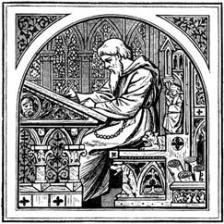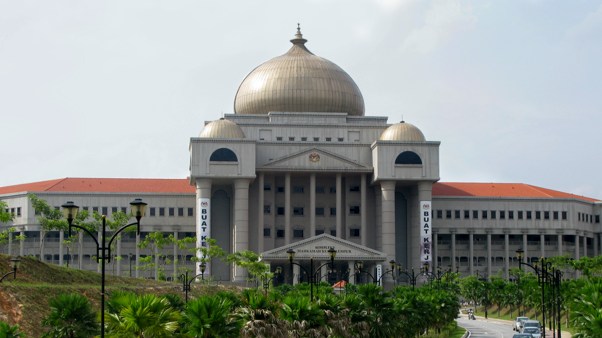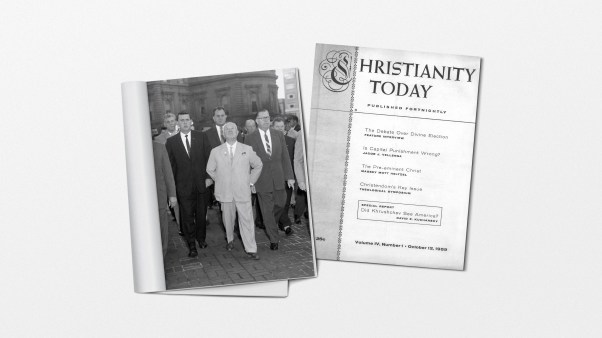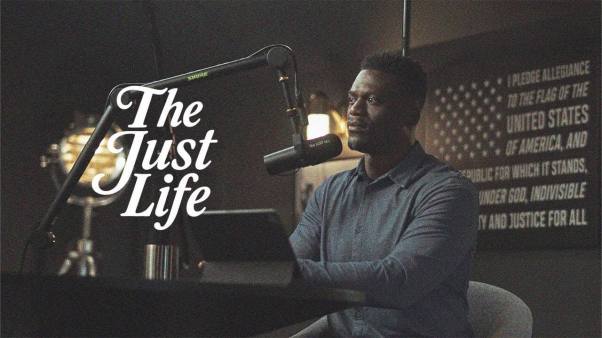 On a recent afternoon on the grounds of St. Andrew’s Church, young men and women danced in a semicircle, swinging to the beat of drums. The group’s leader gestured intently as she marched, signing to the dancers, all silent but for a few muted sounds as they rehearsed the hymn “Oh How He Loves Me.”
On a recent afternoon on the grounds of St. Andrew’s Church, young men and women danced in a semicircle, swinging to the beat of drums. The group’s leader gestured intently as she marched, signing to the dancers, all silent but for a few muted sounds as they rehearsed the hymn “Oh How He Loves Me.”The group belongs to St. Andrew’s deaf choir, known as the Zion Praise Team. The choir masters hymns and worship songs in American Sign Language, thrilling congregations at worship services in the Presbyterian church and other Christian churches around this East African country.
“The group knows its strength is in the music,” said Judy Kihumba, 32, a hearing disability ministry coordinator at the church. “When practicing on this ground, they find more space to move freely.”
The deaf singers are freed spiritually as well. “When they sing, it’s a soul-edifying activity, its therapy for them and it’s also a way of worship. They feel closer to God through this,” said Kihumba.
Kihumba, who was named to the BBC’s list of 100 top inspiring and influential women in the world last year, is the founder of Talking Hands, Listening Eyes on Postpartum Depression, an organization that helps deaf women navigate motherhood, advocating for their maternal and mental health.
Participation in the choir is also an avenue of religious education for its members. Being deaf, Kihumba explained, “means they don’t interact and understand the Bible at a young age because their family members don’t know sign language.”
It’s also liberating simply having the stage to themselves. “The deaf love singing since it’s the only way they don’t get interruptions. It also comes from the deepest point of their hearts,” she added.
Among the group’s most popular songs, according to choir members, is “Amazing Grace,” which they say shows how God always cares for them.
Priscah Odongo, an IT technician who has been the choir’s leader for the last five years, said her tasks include ensuring that the singers’ signs stay in sync with the chords being played. Odongo joined the choir in 2015, she said, to worship through singing.
“I also wanted to prove to the world that people with hearing impairment have talents and can do things just like the hearing,” said Odongo, 36. “I feel good when leading the choir during Sunday worship services or any other place we are called to.”
The deaf choir’s success is clarifying widely held misconceptions that people with disabilities are a burden to society.
“The ministry of Zion Choir debunks the myth that persons with disabilities are there to receive without giving back to the community,” said Sudan Nderitu, a long-serving hearing member of the choir, who works with people with disabilities professionally.
She explains that the choir members have a variety of talents and skills—they are electrical technicians, carpentry workers, and IT experts, as well as dressmakers and tailors. “We wear uniforms made by one of us,” said Nderitu, who adds that she advises the deaf members to introduce themselves in full. “I tell them to say who they are, what they can do and what skills they possess.”
The choir was started in 1992 by Kum Hee Moon, a Korean missionary who had founded Young Nak Church of the Deaf in Nairobi. Five years later, that congregation moved to St. Andrew’s, and the choir was integrated into St. Andrew’s music ministry, participating in parish events such as the Music Week.
Lucy Kahaki has been singing with the choir since its founding, when she was barely in her 40s. Now 71, Kahaki finds peace singing with people half her age. Age doesn’t count, she said, as her energy when singing matches that of youthful members.
“Singing is my passion. I sing to praise God. I joined the choir so that other young deaf persons can get the courage to sing for the Lord,” she told Religion News Service.
The Rev. George Obonyo, a choir member and special minister for the deaf in the Nairobi Presbytery of the Presbyterian Church of East Africa, said the choir’s example has helped convince Kenyan churches to embrace deaf culture.
“I am grateful to churches in Kenya … for practicing inclusion,” he said. “I know this will do more in future regarding the inclusion.”
This weekend I am attending the 44th International Congress on Medieval Studies at Western Michigan University in Kalamazoo. This is the largest and most prestigious international gathering for medievalist scholars, convening over 3,000 scholars in over 600 sessions of papers, panel discussions, roundtables, workshops, and performances.
Frankly, though I am no medievalist, just thinking about being there is making me drool.
What’s an American church history geek doing attending a meeting that will feature hundreds of highly technical papers in a field I hardly know, based on texts in languages I’ve never learned – Latin, Old English, Old Norse?
Maybe it’s the new monastics’ fault.
For several years, I’ve been a sympathetic follower-from-afar of this movement.* I have to say that the new monastics sometimes seem curiously oblivious to those values that animated the original monastics. However, they have cautiously reached out to the “old monastics” in venues such as the annual Monastic Institute held at St. John’s Seminary in Collegeville, Minnesota. This has led to some interesting meditations on the value for today’s Christians of monastic disciplines such as obedience, stability of life, and the like. For a fascinating glimpse of this engagement, see Inhabiting the Church, co-authored by Jonathan Wilson-Hartgrove, Tim Otto, and Jon Stock.
Another thing that has spurred me to engage medieval history is . . . well . . . this will raise eyebrows, but I’ll say it: I am a long-time fan of fantasy literature, and a one-time enthusiastic player of Dungeons and Dragons. Both that genre and that game (with all of its countless spinoffs) were inspired by the writings of J. R. R. Tolkien. And if the number of sessions at the Medieval Congress dedicated to Tolkien is any indication, there are plenty of folks doing medieval studies today who love Tolkien – including, I don’t doubt, many who got into the field of medieval studies through reading Tolkien.
The potential lesson here for evangelicals goes beyond The Lord of the Rings. Some of modern evangelicals’ favorite writers are scholars of the medieval period: along with Tolkien we can list C. S. Lewis, G. K. Chesterton, Charles Williams, and Dorothy L. Sayers. Surely we should stop cherry-picking these authors, concentrating on the “mere Christianity” that they defended so eloquently and imaginatively, and ignoring their strong sense that the medieval world has something to show and tell us today.
One more thing that has spurred me to dig into the Middle Ages has been the trend among younger evangelicals toward returning to “tradition” as a resource for tomorrow’s church. Though the main energies of this movement are still focused on the early church, younger Christians in particular are going on retreats at monasteries, practicing the Lectio Divina, and walking labyrinths.
Surely evangelicals who are sampling these medieval wares would benefit by moving beyond a piecemeal, “consumer” approach to medieval Christianity into a more systematic, in-depth study. Beneath the surface of now-trendy medieval practices, and amidst that era’s wrong turnings and corruptions, lies a rich vein of spiritual, intellectual, and practical resources. I can think of at least nine facets of medieval faith and life that we can stand to learn from today:
- their willingness to engage in spiritual disciplines,
- their theologically grounded devotional and even “mystical” practices,
- their high valuation of tradition handed down in texts,
- their passionate search for theological knowledge (fides quaerens intellectum--“faith seeking understanding”),
- their moral seriousness, expressed for example in the lists of “deadly sins” and “cardinal virtues,”
- their adaptation of classical learning to Christian theology (which paved the way for the birth of modern science and continues to provide a model for Christ-culture engagement today),
- their deep affection for the doctrines of creation and incarnation, issuing (for example) in many profoundly spiritual treasures of Western art and literature,
- their high valuation on eternity over temporal life, and the “art of dying well” (ars moriendi) that developed from this commitment, and
- their insistence on works of charity (fides caritate formata–“faith formed by love”).
Well, these sorts of thoughts have spurred me to start reading seriously in the area of medieval studies (still as an amateur, rather than as a scholar), seeking a “usable past.” At the outset, I focused on three figures: Gregory the Great (“father of medieval spirituality” and “Doctor of Desire”), Dante Alighieri (author of the Divine Comedy: Inferno, Purgatorio, and Paradiso), and Margery Kempe (a charismatic and odd laywoman from late-medieval England who has recently been enjoying a resurgence of interest among modern readers – see for example “Mapping Margery Kempe.”). Each of these has become a chapter in my forthcoming IVP book Patron Saints for Postmoderns.
A couple of years ago, given some gracious funding from the Alumni Association at Bethel, I was able to spend a week at Wheaton College’s Marion Wade Center, pulling medieval strings leading from Tolkien, Lewis, Chesterton, and Sayers, to see where they would lead. I was also able to purchase a small starter library of primary and secondary sources in medieval studies. This work morphed into a course at Bethel Seminary, “Medieval Wisdom for Modern Ministry.” (And will soon, I hope, become a book.)
And so tonight at 9 pm, after teaching an internet-based class session from my St. Paul office, I will get into my car, plug in cassette #1 of the BBC’s dramatization of J. R. R. Tolkien’s The Hobbit, and strike out for Kalamazoo. Perhaps by next month’s blog entry, I will have processed that conference’s rich smorgasbord of scholarly medievalism enough to report a few highlights.
Until then, peace – and may the God of Abraham, Isaac, Jacob, Gregory, Dante, Margery, and all the saints be with you.
* What are the “new monastics?” In his influential 1981 book After Virtue, Catholic philosopher Alasdair MacIntyre compared the state of the West to the decadence of the late Roman Empire and called for “another – doubtless very different – St. Benedict.” Then in 1998, in a little book called Living Faithfully in a Fragmented World, Protestant theologian Jonathan R. Wilson transformed McIntyre’s call into a plea for a Protestant “new monasticism.” Since then, Wilson’s own son-in-law Jonathan Wilson-Hartgrove and such other self-identified “new monastics” as Shane Claiborne have “joined up,” forging a new communal lifestyle in urban “abandoned places of empire,” lived out in solidarity with the poor.
Image: Medieval writing desk via Wikimedia Commons from the G. F. Rodwell’s “South by East: Notes of Travel in Southern Europe” (1877)







